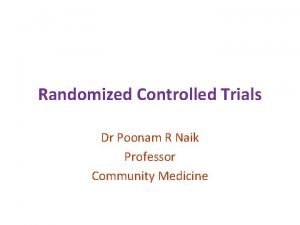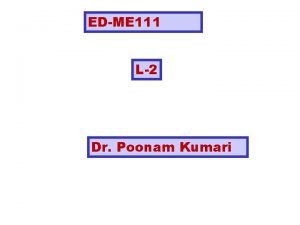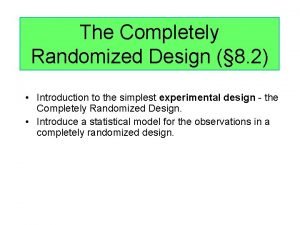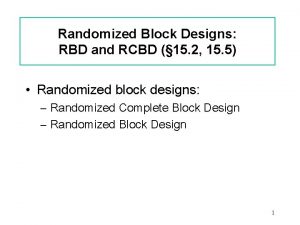Randomized controlled trials Dr Poonam R Naik Introduction















- Slides: 15

Randomized controlled trials Dr Poonam R Naik

Introduction • The objective of both public health & clinical practice is to modify the natural history of a disease so as to prevent or delay disability or death. • In doing so the main challenge in front of us is to select the best available preventive or therapeutic measure

Basic Design of RCT Defined Population Randomization New Treatment Improved Not Improved Current Treatment Improved Not Improved

Steps Involved in RCT 1. Drawing up a Protocol 2. Selecting Suitable sample (reference & experimental population. ) 3. Randomization 4. Manipulation or Intervention (Administer Treatment) 5. Follow-up 6. Assessment of outcome

Reference population Experimental population Inclusion criteria Informed consent Excluded Refused Study population Random allocation Intervention group Control group Losses to follow-up Outcome

Drawing up a Protocol • The protocol should specify: – Aim & objectives – Study Questionnaire – Selection criteria of study subjects – Sample Size – Procedure of allocation of subjects into cases & control – Treatment to be applied – Standardization of working procedure & schedules • Pilot Study.

Selecting Suitable sample (reference & experimental population) • • Inclusion criteria Exclusion criteria Reference or Target Population Allocation of subject to treatment group (experimental or study population) – Randomly selected – Representative of the population – Cooperative – Informed consent – Qualified or eligible for the trial

Randomization “It is a statistical procedure by which the participants are allocated into groups, usually called study group & control group, to receive or not to receive an experimental/preventive/therapeutic measure or intervention”. • The critical element of randomization is the unpredictability of the next assignment.

Types of Randomization • Simple randomization – Table of random numbers – Computer generated randomization-list – Sealed envelopes – Fliping a coin • Stratified randomization • Block randomization

Manipulation or Intervention (Administer Treatment) • The intervention could be deliberate application or withdrawal or reduction of the suspected causal factor which is under the study & as laid down in the protocol

Follow-Up • • • Equal interval of time In standard manner Equal intensity Under same given circumstances In the same time frame

• Possible reasons for non-adherence/ attrition – Developing side effects – Forgetting to take medication – Withdrawing consent – Decide alternative treatment – Health issues: treatment contraindicated, – Death, migration,

Assessment of outcome • The criteria to measure the outcome should be precisely be stated. • Measurable with other studies. • While measuring the outcome one must try to reduce or minimize the bias.

Blinding • Types of blinding – Single blinding – Double blinding – Triple blinding

Types of Randomized Studies • Individuals - Treatment is allocated to individuals. • Community - Treatment is allocated to entire community. • Preventive – Prophylactic agent is given to healthy or high-risk individuals to prevent disease occurrence. • Therapeutic- Treatment is allocated to diseased (Clinical Trials) individuals to reduce the risk of recurrence or improve survival.
 Poonam naik
Poonam naik Poonam naik
Poonam naik Lagu naik naik tangga ukuran
Lagu naik naik tangga ukuran Advantage of randomized controlled trial
Advantage of randomized controlled trial Dr poonam sinha
Dr poonam sinha Dr poonam agarwal
Dr poonam agarwal Poonams day out
Poonams day out Regenerative braking ppt
Regenerative braking ppt Dr poonam kumari
Dr poonam kumari Randomized polynomial time
Randomized polynomial time Completely randomized design
Completely randomized design Randomized skip list
Randomized skip list Solomon four group design
Solomon four group design Randomized block design
Randomized block design Block designs
Block designs Rbd design layout
Rbd design layout



























